Polymer materials

In the research field Polymeric Materials, new fundamental knowledge and skills are developed through scientific materials research, and the know-how and technical prerequisites are created to be able to work on the questions of application-oriented materials development at the ibac.
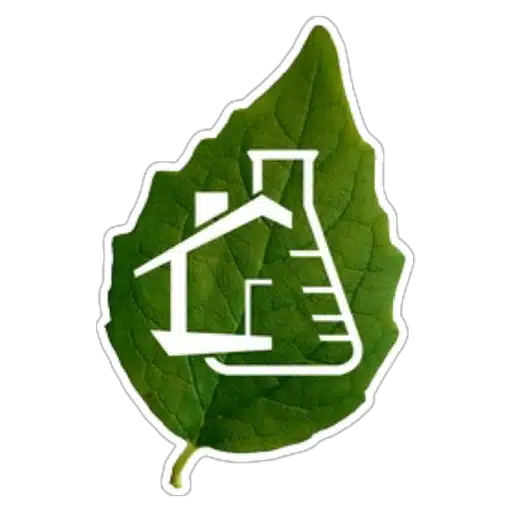
Informationen über aktuelle Entwicklungen, Publikationen und Teamneuigkeiten
Biobasierte Baustoffe
Die Natur stellt eine beeindruckende Vielfalt an Stoffen in großen Mengen bereit, von denen viele bislang ungenutzt bleiben. Jeder dieser Stoffe weist eine einzigartige Kombination an Eigenschaften auf, die ein enormes Potenzial für die Entwicklung neuer Materialien bergen. Dennoch werden zahlreiche dieser Ressourcen entweder thermisch verwertet oder unter erheblichem Aufwand deponiert, anstatt sie nachhaltig in die Wertschöpfungskette zu integrieren.
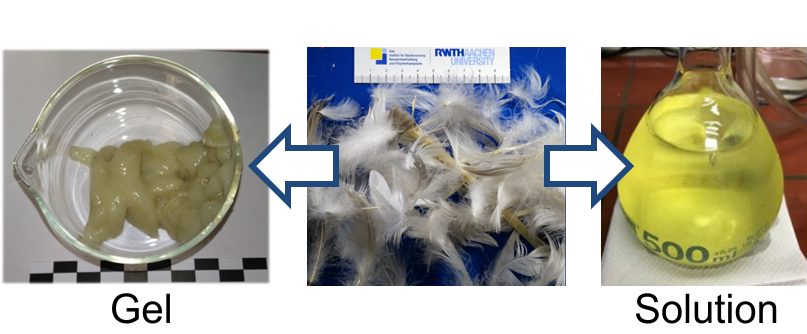
Unser Forschungsschwerpunkt liegt auf der Entwicklung innovativer Methoden zur rohstofflichen und werkstofflichen Nutzung biogener Reststoffe. Dabei konzentrieren wir uns auf Materialien, die von der Natur in großen Mengen produziert, jedoch bislang kaum als Rohstoffe genutzt werden und nicht in Konkurrenz zur Nahrungsmittelproduktion stehen. Zu unseren Hauptquellen zählen Geflügelfedern, Krabbenschalen, Insektenpanzer und Gräser. Durch gezielte chemische Verfahren werden diese Rohstoffe so aufgeschlossen, modifiziert und weiterverarbeitet, dass sie wirtschaftlich nutzbar werden. Dies eröffnet nicht nur neue Anwendungsmöglichkeiten, sondern verbessert auch die CO2-Bilanz und unterstützt die Transformation hin zu einer auf nachwachsenden Rohstoffen basierenden Gesellschaft.
Ein Beispiel für die erfolgreiche Verwertung biogener Reststoffe ist unsere nachhaltige hydrophobe Beschichtung für Holzoberflächen. Holz erlebt aufgrund des steigenden Umweltbewusstseins eine Renaissance, benötigt jedoch Schutz vor Feuchtigkeit, UV-Strahlung und Verunreinigungen. Unsere Beschichtung basiert auf Chitosan, das aus Abfällen der Lebensmittelindustrie gewonnen wird. Neben dem Schutz vor Feuchtigkeit und UV-Strahlung bietet unsere Chitosanitaconat-Beschichtung auch eine erhöhte Feuerbeständigkeit. Unbehandeltes Holz brennt nach der Entzündung meist vollständig ab, selbst ohne kontinuierliche externe Hitzezufuhr. Unsere neue Beschichtung hingegen macht das Holz widerstandsfähiger gegenüber Flammen. Bereits eine einzige Schicht der Beschichtung verringert die Brennrate um ein Drittel. Mehrere Schichten führen dazu, dass das Holz selbstständig erlischt, sobald die externe Flamme entfernt wird.
Ein weiteres Beispiel sind unsere Ergebnisse mit Proteinhydrolysaten aus Geflügelfederabfällen zur Herstellung flammhemmender Faserplatten. Mit diesen Proteinen imprägnierte Holzfasern zeigen eine signifikant verringerte Zersetzungsrate im Bereich zwischen 300 und 450 °C, gemessen durch thermogravimetrische Analyse. Die Endverbrennung der imprägnierten Fasern verschiebt sich um 50 °C in den Bereich von 450 bis 500 °C und erfolgt schrittweise, anstatt sofort wie bei unbehandeltem Holz. Bereits bei einem Proteingehalt von ca. 10 Gew.-% sind die im Nassverfahren hergestellten Platten selbstverlöschend und zeigen nur minimale Nachglut. In Dreipunkt-Biegetests widerstanden diese Faserplatten Belastungen von bis zu 15 N/mm², was der DIN EN 622-Norm für kommerzielle, formaldehydgebundene Faserplatten entspricht. Dies belegt, dass die recycelten Proteinhydrolysate nicht nur eine beeindruckende flammhemmende Wirkung besitzen, sondern auch als vollständig nachhaltiges Bindemittel für eine neue Generation ökologischer Faserplatten eingesetzt werden können. Da diese Platten ausschließlich aus natürlichen Materialien bestehen, können sie nach ihrer Nutzung geschreddert und kompostiert werden.
Contact person: Nils Münstermann, Paul Marten, Fabian Weitenhagen, Lena Schmitz
Current projects: Biobasierte Polyesterharze für Tiefziehverfahren (BioHarz) ❖ Glasverklebung mit biogenen Reststoffen ❖ Filzgleiter ❖ Nachhaltige Spanplatten
Completed projects: Biokompositwerkstoffe ❖ Biobasierte Lasuren und Klebstoffe für Holz ❖ Biosuperabsorber ❖ Recyclingschäume ❖ KeraSan ❖ bio-based compounds ❖ Chitin-based bioplastics ❖ Building material from feathers ❖ Fire protection wood
Gele in der Bauwerksinstandhaltung
Die Erhaltung und Sanierung bestehender Bauwerke stellt eine zentrale Herausforderung im modernen Bauwesen dar. Konventionelle Methoden erfordern oft einen tiefgreifenden Eingriff in die Bausubstanz und sind mit erheblichem Materialaufwand sowie hohen Kosten verbunden. Hydrogele – dreidimensionale, wasserquellbare Polymernetzwerke – bieten hier eine ressourcenschonende Alternative. Hydrogele sind vielseitig anpassbar und werden daher bereits erfolgreich in der Industrie genutzt.
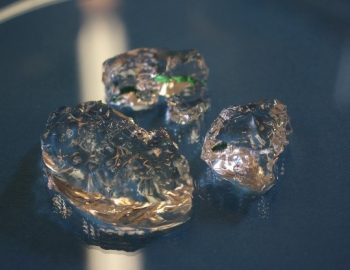
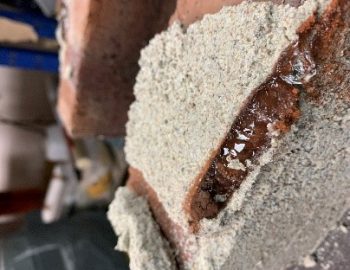
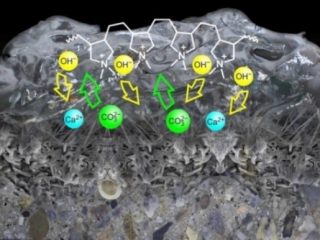
Neben der Feuchteregulierung eignen sich Hydrogele auch zur Sanierung von Stahlbeton, der durch Carbonatisierung und Chlorideintrag geschädigt werden kann. Hochalkalische Hydrogele bieten hier einen innovativen Ansatz, da sie mittels Ionenaustauschmechanismen Carbonationen aus dem Porengefüge entfernen und durch Hydroxidionen ersetzen, wodurch der ursprüngliche alkalische Schutz des Betons wiederhergestellt wird. Ihre elektrische Leitfähigkeit macht sie zudem als Kopplungsmedium für elektrochemische Verfahren wie die elektrochemische Chloridentfernung (Electrochemical Chloride Extraction, ECE) nutzbar. Durch gezielte Anpassung ihrer rheologischen Eigenschaften können sie an vertikalen Flächen, in Hohlräumen oder in feinen Rissen appliziert werden, ohne unkontrolliert abzulaufen. Ein weiterer Vorteil liegt in ihrer reversiblen Anwendung: Nach Abschluss des Sanierungsprozesses lassen sich die Gele rückstandslos von der Oberfläche entfernen.
Aktuelle Forschungsprojekte konzentrieren sich darauf, die ionischen Austauschprozesse gezielt zu steuern, um die Effizienz der Hydrogele in der Bauwerkserhaltung weiter zu verbessern. Zudem wird an der Optimierung der Wasserdampf- und Feuchtesorptionseigenschaften für unterschiedliche klimatische Bedingungen gearbeitet. Ein weiteres Ziel ist die Entwicklung skalierbarer Herstellungs- und Applikationsprozesse, um Hydrogele in großflächigen industriellen Anwendungen wirtschaftlich einsetzbar zu machen.
Durch die Integration von Hydrogel-Technologien in das Bauwesen ergeben sich neue Möglichkeiten für eine nachhaltige Bauwerkserhaltung und -sanierung. Die gezielte Modifikation ihrer chemischen und physikalischen Eigenschaften erlaubt eine flexible Anpassung an spezifische Anwendungsbereiche und eröffnet damit neue Perspektiven für den ressourcenschonenden Umgang mit bestehenden Bauwerken.
Contact person: Tim Mrohs
Current projects: Hochalkalische Hydrogele zur Verhinderung karbonatisierungsbedingter Korrosionsprozesse (Gelko)
Completed projects: Development of a cationic hydrogel for concrete restoration ❖ Development of a 2-component rehabilitation system for the treatment of crack flanks in reinforced concrete ❖ Chloride extraction with hydrogels
Ion conductive polymers
Electrically and ionically conductive polymer materials based on polyethylene glycol and lithium salts not only play a central role in the energy industry, but also have great potential in the construction industry. The electrical properties form the basis of our application-oriented material development with the current focus on electrochromic detectors and polymer sensors in their applications for the detection of reinforcing steel corrosion.
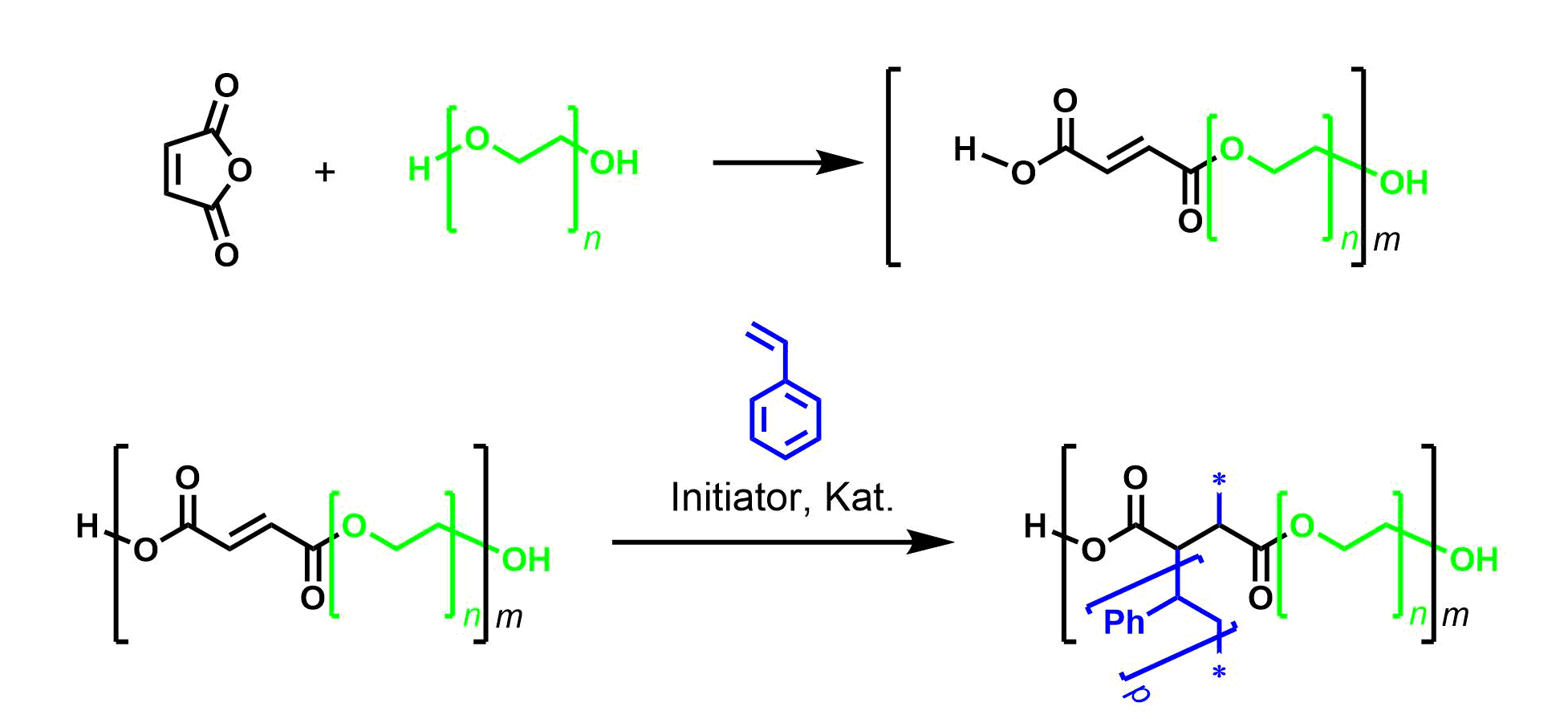
Within the focus "Ion-conductive polymers", the main work for us chemists is in the area of preparative and applied polymer chemistry and we use the methods of "classical" chemical structure elucidation, such as NMR, IR or DSC. In addition, we use typical electronic measuring methods, impedance spectroscopy (EIS) and cyclic voltammetry. In the sense of interdisciplinary technology transfer, we transfer chemical facts to problems from the engineering field and thus make a significant contribution to the further development of the solution-oriented strategy pool.
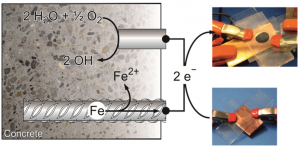
Contact person: Prof. Oliver Weichold
Current projects:
Completed projects: Development of an in situ manufactured multi-ring electrode for depth-graded monitoring of moisture behaviour in concrete components ❖ Electrochromic components for use in a corrosion or CCP monitoring system ❖ Development of a system for permanent monitoring of corrosion in reinforced concrete components based on novel injectable polymer sensors
Job offers
Theses (Chemistry, Civil Engineering, UIW)
Looking for a Bachelor's or Master's thesis? If you are interested in one of our topics, please get in touch with Nils Münstermann or one of the above contacts for a non-binding discussion.
Research practicals (Chemistry M. Sc.)
Students on the Chemistry (M. Sc.) course can carry out the freely selectable research internship with us. If you are interested in one of the above-mentioned research areas, please contact the responsible contact person, Nils Münstermann , directly or come by for a non-binding discussion by appointment.
Student research projects (UIW)
We offer students on the environmental and technological aspects of our key research areas the opportunity to carry out student research projects in environmental engineering. Please contact Nils Münstermann directly if you have any questions about the topics or a more precise definition.
